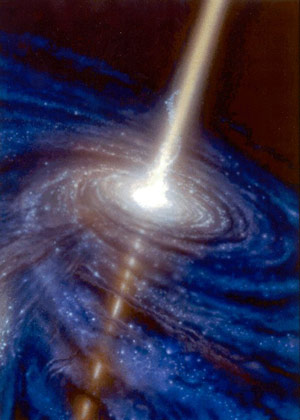 When it comes to black holes, there are some things we know a lot about them – in general. How they form, how they affect space around them, how they eat matter.
When it comes to black holes, there are some things we know a lot about them – in general. How they form, how they affect space around them, how they eat matter.
The details, though, are maddening. We know, for example, that black holes spin – as odd as that may sound – but how they get that spin and how spin changes over time is elusive knowledge.
A new study has given us an idea of that now, though. Here’s how this works: we see that as matter falls into them, some black holes generate twin beams, called jets, which shoot away from their poles. We see this from black holes that form when stars explode, and we see them in the supermassive black holes that inhabit the centers of all big galaxies, too. We know that various physical features of the jets are tied to the rate at which the black holes spin, and this new study makes this connection more clear. The astronomers used computer models to correlate spin to the jets, and observations appear to confirm these models.
Two very interesting results came out of the study. One is that in the past black holes tended to spin more slowly than they do today (that was found by looking at very distant galaxies with black holes in their centers; looking far away in distance is like seeing back in time; in this case several billion years). Something has changed between then and now. And that’s tied to the second interesting bit: black holes that grew by merging with other black holes – by eating each other! – appear to spin faster than ones that simply had matter fall into them. That’s not overwhelmingly surprising to me; the amount of angular momentum you can get by having two black holes merge is fierce. An event like that would spin up a black hole hellaciously.
Black hole mergers can occur when two galaxies collide. Each galaxy has their own supermassive black hole in their hearts, and these can merge over a timescale of a few billion years. That would explain why we see more faster spinning holes now. There’s been time for them to eat each other.
These results are tentative, I’ll note. There are some predictions made by this hypothesis that may be observable as our technology gets better, but it’ll be a few years. I’ll be curious to see how it pans out; the idea makes sense to me, and I’d be surprised if evidence comes along that shows it’s grossly wrong. But we’ve been fooled before by ideas that felt right. I suspect that what we’ll see is that this idea is right in general, but the details will need lots of tweaking. That’s usually the way it is with science… and that’s where a lot of the fun is.
Jet illustration: Don Dixon/NASA/JPL-Caltech.
Related posts:
- Followup on the star torn apart by a black hole
- A tiny galaxy holds a big secret
- Evidence and theory collide with galactic proportions
- Astronomers may have found youngest black hole
- Black hole erupts in nearby galaxy